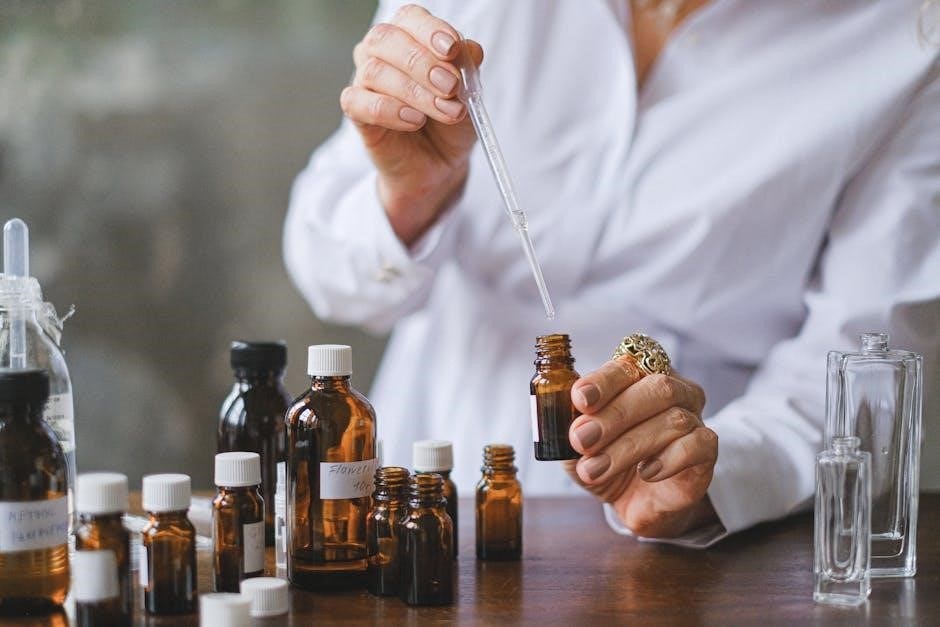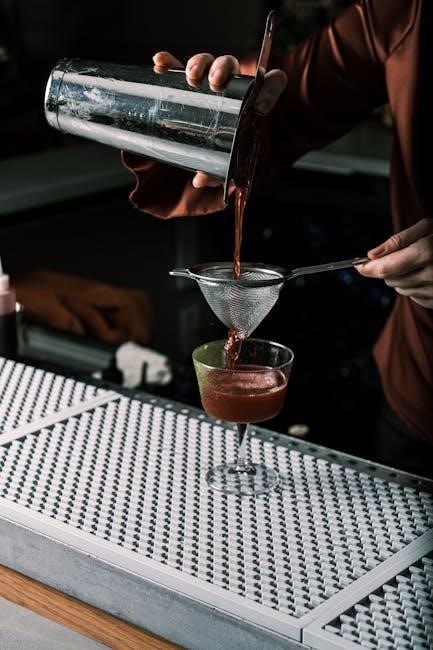
Permethrin 13.3 is a synthetic insecticide in the pyrethroid family, effective against ticks and other pests. Widely used in agriculture and public health, it’s a key component in tick control programs. Known for its low toxicity to mammals and environmental friendliness compared to older pesticides.
1.1. What is Permethrin 13.3?
Permethrin 13.3 is a synthetic pyrethroid insecticide designed to control a wide range of pests, including ticks, mosquitoes, and agricultural insects. It is a concentrated formula typically used in various applications such as area sprays, animal treatments, and clothing/gear impregnation. The “13.3” refers to the active ingredient concentration, making it suitable for both agricultural and non-agricultural pest management. Known for its effectiveness and relatively low toxicity to mammals, permethrin 13.3 is a popular choice for tick control programs and livestock protection.

1.2. Common Uses of Permethrin 13.3
Permethrin 13.3 is widely used for controlling ticks, mosquitoes, and other pests in agricultural settings, livestock operations, and public health campaigns. Common applications include area spraying on pastures, animal housing, and outdoor spaces. It is also applied directly to livestock such as cattle, horses, and sheep to protect against ectoparasites. Additionally, permethrin 13.3 is used to treat clothing and gear to repel ticks and other biting insects, enhancing personal protection. Its versatility makes it a key tool in integrated pest management strategies for both agricultural and residential environments, ensuring effective pest control with minimal environmental impact.

Safety Precautions Before Mixing
Wear appropriate PPE, including gloves, goggles, and a mask, to avoid skin and eye contact. Ensure good ventilation and avoid inhaling spray mist during mixing.
2.1. Personal Protective Equipment (PPE)
When mixing Permethrin 13.3, it is essential to wear appropriate Personal Protective Equipment (PPE) to minimize exposure risks. This includes long-sleeved shirts, long pants, closed-toe shoes, chemical-resistant gloves, and protective eyewear such as goggles or glasses with a splash guard. A dust/mist respirator is also recommended to avoid inhaling any spray mist. Ensure all clothing and gear are clean and free from holes or tears to prevent skin contact. These precautions are critical to safeguarding your health while handling the product. Always refer to the product label for specific PPE recommendations, as requirements may vary based on the application method and concentration of the mixture.
2.2. Reentry Times After Application
Reentry times after applying Permethrin 13.3 are crucial for ensuring safety and minimizing exposure risks. According to the product label, treated areas can generally be reentered once the spray has dried completely. This guideline helps ensure that residual effects are minimized. However, it’s important to note that reentry times may vary depending on the specific application method and concentration of the mixture. For instance, in agricultural settings with extensive spraying, additional precautions might be necessary. Always refer to the product label for precise reentry instructions. Proper adherence to these guidelines is essential to prevent any potential health risks associated with Permethrin 13.3 use. Ensuring the area is well-ventilated can also help reduce any lingering vapors.

Mixing Instructions for Permethrin 13.3
Permethrin 13.3 is mixed at rates of 2 2/3 to 5 1/2 oz. per gallon of water for ticks. Dilute with 2.5 times water for clothing treatment, ensuring effective pest control while maintaining safety standards.
3.1. Mixing Rates for Ticks
Permethrin 13.3 is mixed at a rate of 2 2/3 to 5 1/2 ounces per gallon of water for effective tick control. The lower concentration (2 2/3 oz) is typically used for general tick management, while the higher concentration (5 1/2 oz) is reserved for severe infestations or high-risk areas. Always dilute the product in water according to the label instructions to ensure proper efficacy and safety. Mix the concentrate thoroughly with water to create a uniform solution. This mixture can then be applied using automated spray systems or other approved methods. Make sure to wait until the spray is completely dry before reentering treated areas to minimize exposure risks. Follow label guidelines for specific application rates and safety precautions.
3.2. Mixing Rates for Other Pests
For pests other than ticks, such as fleas, mosquitoes, and flies, Permethrin 13.3 is typically mixed at a rate of 1 to 2 ounces per gallon of water. This concentration is effective for controlling a wide range of insects while maintaining safety for treated areas. The exact mixing rate may vary depending on the severity of the pest infestation and the specific application method. Always refer to the product label for precise instructions, as overuse can lead to environmental concerns. For example, when targeting roaches or grain insects, the lower end of the range (1 oz per gallon) is often sufficient. Higher rates (up to 2 oz) are reserved for more persistent pests or larger treatment areas. Ensure the solution is well-mixed before application to guarantee optimal results.
3.3. Adjusting Mixtures for Different Applications
Permethrin 13.3 mixtures can be adjusted based on the application method and target area. For example, when treating clothing or gear, a more diluted solution (1.25 L water to 0.5 L product) is recommended to ensure safety while maintaining effectiveness. For area sprays, the standard concentration is often used, but nozzles should be adjusted to cover the target area evenly. Direct application on animals may require a different dilution rate to avoid harming the animal while controlling pests. Always consider the specific instructions for the application method to ensure proper coverage and safety. Adjustments should be made carefully to avoid overuse, which could harm non-target organisms or the environment. Refer to the product label for detailed guidance on specific applications.

Application Methods
Permethrin 13.3 can be applied via area sprays, direct application on animals, or treating clothing and gear. Always refer to the product label for specific guidelines.
4.1. Area Spray Using Automatic Systems
Area spray using automatic systems is an efficient method for applying Permethrin 13.3. Ensure nozzles are directed toward the target area and away from non-target zones. Systems should be calibrated to deliver the correct volume, ensuring uniform coverage. Always follow the system’s user manual for specific setup and operational instructions. Diluted concentrate is dispensed through the automatic spraying system, providing consistent application rates. This method is particularly useful for large-scale treatments, such as in agricultural settings or public spaces, where manual application would be impractical. Proper calibration and adherence to guidelines are crucial to maximize effectiveness and minimize environmental impact;
4.2. Direct Application on Animals
Permethrin 13.3 can be applied directly to animals to control ticks, lice, and mites. For livestock such as cattle, horses, and sheep, the product is typically diluted according to label instructions and applied using spray or dip methods. The solution should be evenly distributed to ensure thorough coverage. For smaller animals like dogs, the product is often diluted to a lower concentration and applied directly to the fur or skin. Always follow the recommended mixing rates to avoid overdosing, which could harm the animal. Direct application is most effective when combined with other pest control measures, such as treating the animal’s living environment. Ensure the solution is fully dry before allowing animals to reenter treated areas.
4.3. Treating Clothing and Gear
Permethrin 13.3 is commonly used to treat clothing and gear for tick repellency. Mix 1.25 liters of water with 0.5 liters of Permethrin 13.3 to create 1.75 liters of solution for this purpose. This treatment is effective at repelling and killing ticks, making it ideal for outdoor activities. Apply the solution evenly to fabrics, ensuring complete coverage. Allow the treated items to air dry fully before use. This method is particularly useful for camping, hunting, or working in tick-prone areas. Treated clothing retains its effectiveness through multiple washes, providing long-lasting protection. Always follow the recommended mixing rates to ensure safety and efficacy.

Target Pests and Usage
Permethrin 13.3 effectively targets ticks, roaches, grain insects, cluster flies, bees, and other pests. It is widely used in agricultural, outdoor, and domestic settings for pest control and management.
5.1. Pests Controlled by Permethrin 13.3
Permethrin 13.3 effectively controls a wide range of pests, including ticks, mosquitoes, flies, fleas, roaches, grain insects, cluster flies, and bees. It is particularly renowned for its efficacy against ticks, making it a key component in tick control programs. Additionally, it targets various agricultural pests, such as those affecting livestock and crops. Its broad-spectrum activity ensures it is versatile for use in both outdoor and domestic settings. This makes Permethrin 13.3 a reliable choice for managing pest infestations in diverse environments, from farms to residential areas. Its effectiveness against multiple pest species contributes to its popularity in agricultural and public health applications.

5.2. Specific Instructions for Livestock
Permethrin 13.3 is specifically formulated for use on livestock, including beef and dairy cattle, horses, sheep, goats, swine, poultry, and dogs. When applying to livestock, ensure the product is used at the recommended rate to avoid over-application, which can lead to toxicity. For ticks, the mixing rate is typically 2 2/3 to 5 1/2 ounces per gallon of water. Apply directly to the animal or premises, following label guidelines. Avoid application on stressed or newborn animals. Reentry times vary depending on the livestock and application method, so consult the label for specific instructions. This ensures safe and effective pest control while protecting the health of the animals.

Environmental Considerations
Permethrin 13.3 can impact aquatic ecosystems and non-target organisms like bees. Avoid spray drift and runoff to protect water sources and beneficial insects. Ensure proper application.
6.1. Impact on Non-Target Organisms
Permethrin 13.3 can adversely affect non-target organisms, particularly aquatic life. Fish and aquatic invertebrates are highly sensitive to permethrin, even at low concentrations. Bees and other pollinators may also be impacted if exposed to treated areas. Birds are less susceptible but can be affected if they ingest contaminated insects. Beneficial insects, such as ladybugs and parasitic wasps, may experience reduced populations due to permethrin’s broad-spectrum activity. Proper application and adherence to label instructions are crucial to minimize these risks and protect ecosystems. Avoiding spray drift and runoff into waterways is essential to safeguard aquatic habitats and non-target species.
6.2. Avoiding Contamination of Water Sources
Preventing permethrin 13.3 contamination of water sources is critical to protect aquatic ecosystems. Permethrin is highly toxic to fish and aquatic invertebrates, even at low concentrations. To avoid contamination, avoid spraying near water bodies, drainage ditches, or areas where runoff may occur. Use containment measures when mixing to prevent accidental spills. Ensure proper disposal of unused product and rinse water, following local regulations. Avoid treating animals near water sources, as residues can wash into aquatic habitats. Regularly inspect and maintain application equipment to prevent leaks or drips. By adhering to these precautions, the risk of water contamination can be minimized, safeguarding both aquatic life and the environment.

Storage and Disposal
Store permethrin 13.3 in a cool, dry place away from direct sunlight. Ensure containers are tightly sealed and inaccessible to children. Dispose of unused product and containers according to local regulations. Do not pour leftover mixture into drains or waterways, as it may cause environmental harm. Proper disposal helps protect the environment and human health.
7.1. Proper Storage Conditions
Permethrin 13.3 should be stored in a cool, dry, well-ventilated area away from direct sunlight and heat sources. Keep the product in its original container with the label intact. Ensure the container is tightly sealed to prevent leakage or contamination. Store it out of reach of children, pets, and unauthorized personnel. Avoid storing it near flammable materials or in areas prone to moisture accumulation. The ideal storage temperature is between 40°F and 90°F (4°C and 32°C). Do not store it in vehicles or unventilated areas. Proper storage helps maintain the product’s effectiveness and ensures safety. Always follow the label instructions for specific storage recommendations.
7;2. Disposal of Unused Product

Dispose of unused Permethrin 13.3 and its container in accordance with federal, state, and local regulations. Do not discharge into drains or waterways, as it may contaminate water sources. If the product is unused or expired, contact a licensed hazardous waste disposal facility for proper handling. Empty containers should be rinsed thoroughly and disposed of in a sanitary landfill. Do not reuse the container for other purposes. Always follow local guidelines for pesticide disposal to minimize environmental impact. Proper disposal ensures the protection of aquatic life and prevents contamination of soil and water. Never dispose of the product near water sources or in areas where it may leach into groundwater.
Always follow label instructions for safe and effective use of Permethrin 13.3. Proper mixing and application ensure optimal results while minimizing environmental impact and health risks.
8.1. Final Tips for Effective Use
For optimal results with Permethrin 13.3, always adhere to the recommended mixing rates and application methods. Ensure thorough coverage of target areas to maximize pest control efficiency. Regularly inspect equipment and nozzles to maintain proper spray distribution. Avoid applying during peak sun hours or when rain is expected to prevent product degradation. Keep the treated area undisturbed until the solution has fully dried. For clothing and gear, follow the dilution guidelines precisely to ensure both effectiveness and safety. Remember, consistency in application and adherence to instructions are key to achieving long-lasting protection against ticks and other pests.
8.2. Importance of Following Label Instructions
Adhering to the label instructions for Permethrin 13.3 is crucial for ensuring both effectiveness and safety. Deviating from recommended mixing rates or application methods can lead to reduced efficacy or potential harm to people, animals, or the environment. Proper dilution and application techniques prevent overuse, minimizing the risk of chemical resistance in pests. Additionally, following label guidelines helps avoid contamination of water sources and protects non-target organisms. Always check reentry times to ensure safety for individuals and animals entering treated areas. Compliance with label instructions also ensures legal adherence to environmental and agricultural regulations. By following these guidelines, users can maximize the benefits of Permethrin 13.3 while maintaining safety and environmental responsibility.